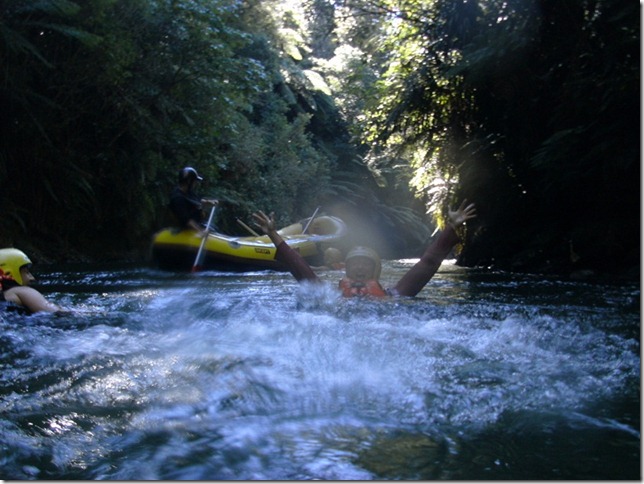After a nice stop in the beautiful, laid-back surfer town of Piha, we headed back toward Tauranga and the boat. Before getting back to work, we took one more day to do one of the NZ adventure activities that we’d been wanting to try – white water rafting. We drove to nearby Rotorua to raft the Kaituna River, including the world’s largest commercially raftable waterfall at 7 meters. It was definitely a bit of get-your-blood-pumping adventure in the beginning as the river is lined with rocks, cliffs and boulders and the water is rushing through at an intimidating rate. The briefing on how to assume the proper position when going down a waterfall and what to do if you fall out going down a waterfall added to the anticipation, but after passing over a couple of small waterfalls in our 4.5m raft, we soon felt pretty comfortable and were ready for more. The rafting guide even let us get out and drift in the river’s strong current for a bit, and I barely managed to get back in and partially seated before we slid down one of the several waterfalls. The 7 meter waterfall was a bit scary at first as all you could see was a narrow portion of the river with rocks on both sides and then spray rising up from where the water crashed into the unseen river below. The trip before, one of the rafts had flipped coming down the large falls, and sledging (essentially riding the river on a boogie board) was no longer done commercially on this falls due to frequent injuries. After an exhilarating plunge, we looked back at the falls and didn’t see any way it could be as tall as 7 meters, but that’s the official number. We could have enjoyed the river all day, but we were soaking wet and at the pick-up spot after about an hour, so it was time to head back to Tauranga and enjoy a little relaxation on the beach before digging into boat work the next day.
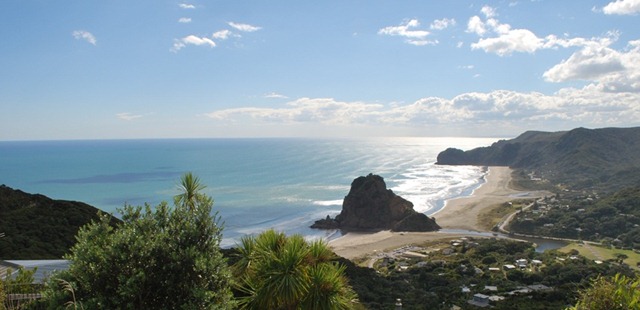 Beautiful surf spot Piha Beach
Beautiful surf spot Piha Beach
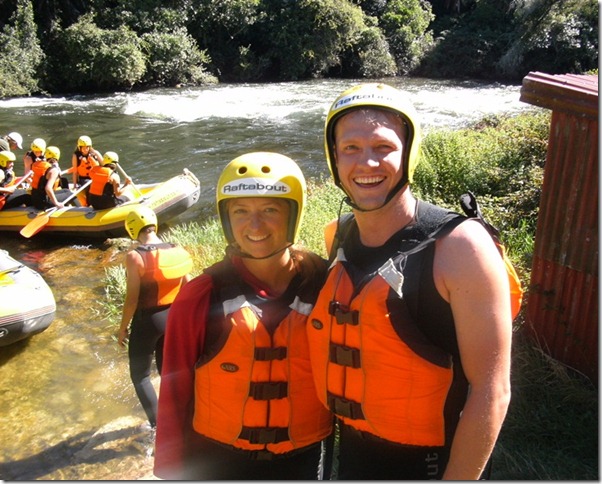 Hey, that helmet would make your head look pretty funny too…
Hey, that helmet would make your head look pretty funny too…
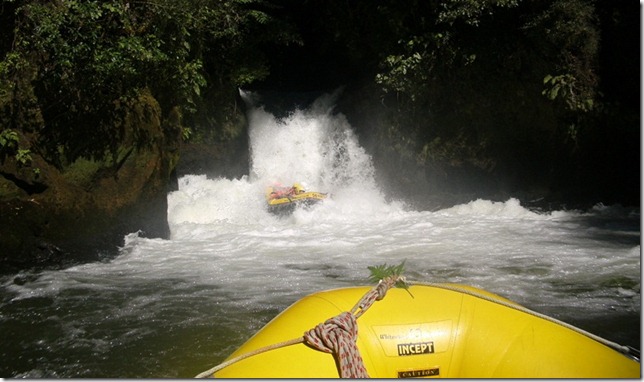 The big waterfall – the raft is 4.5 meters long
The big waterfall – the raft is 4.5 meters long
When we got back to the boat, there was one large task remaining to get her back in the water – another starboard keel repair. There was still a bit of moisture left in the keel due to the previous owner colliding with a reef. Wes’s repair from Block Island had held up well, but there was another spot farther down that was damp. I drilled the keel, drained the moisture, and within a few days, it was dry enough to start the repair. With instruction from the experts here at the boatyard, I first formed a piece of wood (timber or TEEM-buh as they say here) that would fill the gap that I ground to remove the bad areas. Next, the guys at the boatyard epoxied the wood in, and I ground everything down again to fair it and to extend the exposed area to good glass on all sides. Next the new layers of glass were applied, and I added a layer of underwater fairing compound. Now all we have left is some sanding and painting and the keel will be ready to go.
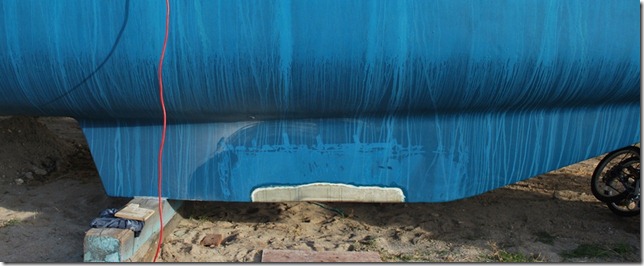 How’s that for an action shot – the keel with new glass curing
How’s that for an action shot – the keel with new glass curing
The bad news is that we found a bit of a rudder problem as well. I’d already planned on dropping the port rudder to do a bit of lubrication, but I’d forgotten to mention to Lauren that the rudder has to be dropped while the boat is in the air during the haul-out, otherwise a hole has to be dug underneath the rudder in order to drop the rudder shaft all the way out of its tube. So, I spent a good part of Sunday morning digging a 4 foot hole under the boat. Luckily, the ground was mostly soft and sandy (I think this area is re-claimed shoreline), but the next day I definitely felt a few muscles that I hadn’t used much over the last couple of months. The bad news came when we were checking out the rudder before actually dropping it. We noticed that the rudder moved a bit relative to the rudder shaft, which is generally pretty bad news. It usually means that the shaft is loose in the rudder and that rudder failure (a potential disaster at sea) is a matter of time. Rudders are a custom and expensive item to build (having two built would probably be $5k-$10k), so it wasn’t a good afternoon. I talked with the boat builder here at the yard and we initially considered drilling the rudder in a few key places to inject epoxy and stop the movement, but with so many sea miles still to go, I decided to go ahead and open it up to assess things a little better. In the end, we found a really solid rudder construction. Water had crept in around the shaft, but it was so well sealed from the wood body of the rudder that things were still in good shape and we were in no danger of losing our rudder. Our rudder repair now consists of drying out the rudder and rebuilding the portion we opened up. I’ve done some of the work and the guys at the yard have done other parts. Hopefully we’ll have it back on and painted next week so we can finally get back into the water.
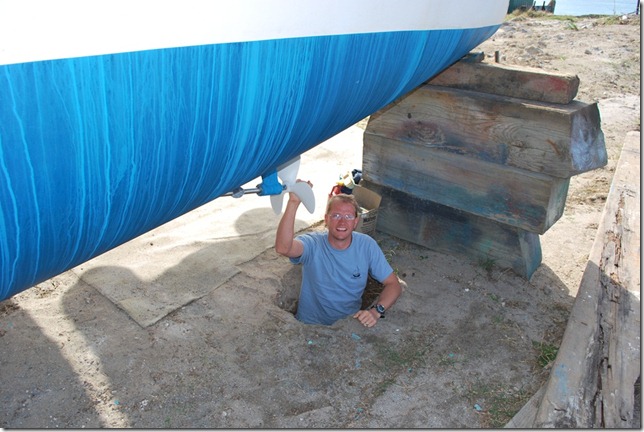 How I’m spending my summer vacation
How I’m spending my summer vacation
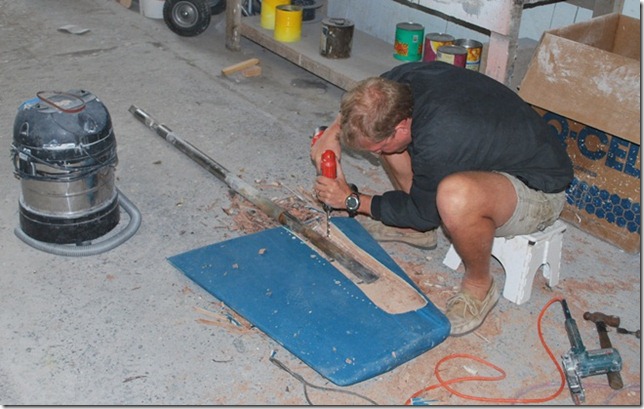 The beginning of a week rebuilding the rudder, fighting back the tears. Why do I own a boat?
The beginning of a week rebuilding the rudder, fighting back the tears. Why do I own a boat?
In the meantime, we’ve been doing a number of other repairs as well, trying work our way through the list of things that need to be done before we can set sail for Fiji (hopefully the first week in May). One of those issues is crew. Wes’s contract position in the US won’t allow him to return until August at the earliest, so we’ve been keeping an eye out for potential crew. It looks like we’ll be heading to Fiji with a Kiwi, Ash, who we first met in Tonga while he was waiting to crew on a Tonga to New Zealand delivery. He’s a fun guy that we’ve enjoyed hanging out with and is working on yachting certifications, so the passages will be a good source of miles and experience for him as well as a good chance for us to have some fun and experienced crew. We’re also going to be joined by Shiroma, a Sri Lankan girl raised in Germany who’s been travelling around New Zealand for several months. Once we get to Fiji, we’ll be joined by Colin, a long-time friend of ours from our University of Kansas days who’s going to be sailing with us for several months. The signs of fall are starting to be obvious — the leaves are starting to change colors, nights are cold, and the daylight hours are getting shorter. We’re anxious to get back on the water and into the tropics again for another season of adventure. Hopefully two more busy weeks will have us ready.


